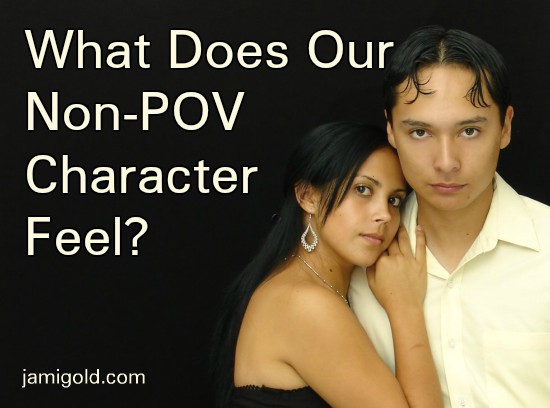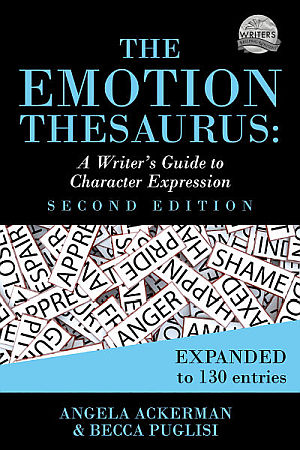6 Ways to Show Emotions for Non-POV Characters — Guest: Becca Puglisi

Two weeks ago, I helped Angela Ackerman and Becca Puglisi of Writers Helping Writers announce their latest Thesaurus book: the second edition of their amazing Emotion Thesaurus. I love the first edition and am eagerly awaiting the second edition’s release in two weeks. Woo hoo!
The ET has helped me so much by broadening my “vocabulary” in how to show my characters’ emotions. Plus, as I’ve written about before, the ET can also help us avoid four common writing problems, including clichés and flat descriptions.
One of the other issues the ET can help us with is head hopping—shifting the point of view (POV) from character to character without a clear transition—especially when we want the reader to pick up information from a non-POV character. Intentional head hopping because we think we need to change POV to get information across to the reader is often a sign of lazy writing.
How do we avoid it? First, make sure that we actually need to share the information we think we do. Then read today’s post from ET co-author and emotion-expert Becca Puglisi, who’s here to give us 6 techniques we can use to show emotion for our non-POV characters. *grin*
Please welcome Becca Puglisi!
*****
How to Show Emotion for Non-Viewpoint Characters
By Becca Puglisi
Those of you who are familiar with me know that Angela Ackerman and I talk a lot about emotion. A LOT.
That’s because we believe that clearly conveying emotion—particularly that of the protagonist or viewpoint character—plays an important role in building reader empathy. If we can build a strong connection for the reader, they’ll become invested in the character and be more likely to keep reading.
The other reason character emotion is so important is that it draws the reader into the story. If we’re able to show emotion well, we heighten the reader’s experience; instead of them sitting back and being told about the character’s emotions, they’re feeling them as the story goes along. They’re invited to share in the journey.
That level of engagement is critical if we’re going to pull readers into our stories and keep them there.
Quick Recap: How Do Emotional Cues Work?
Here’s an example of character emotion that has been shown, taken from the newly published 2nd Edition of the Emotion Thesaurus:
JoAnne sat on the chair’s edge, spine straight as a new pencil, and stared into Mr. Paxton’s face. Sixteen years she’d given him—days she was sick, days the kids were sick—making the trip back and forth across town on that sweaty bus. Now he wouldn’t even look at her, just kept fiddling with her folder and pushing around the fancy knickknacks on his desk. Maybe he didn’t want to give her the news, but she wasn’t gonna make it easy for him.
Mr. Paxton cleared his throat for the hundredth time. The vinyl of JoAnne’s purse crackled and she lightened her grip on it. Her picture of the kids was in there and she didn’t want it creased.
“JoAnne…Mrs. Benson…it appears that your position with the company is no longer—”
JoAnne jerked to her feet, sending her chair flying over the tile. It hit the wall with a satisfying bang as she stormed out of the office.
Through a combination of body language, thoughts, and reactions, we can see what JoAnne is feeling without her ever stating it outright. And because we’ve also learned something about who she is and where she’s coming from, our empathy is piqued. So showing emotion for our protagonist pays off in spades.
But How Do Emotions Work for Other Characters?
That example may not be news to you, since the importance of showing emotion has been discussed quite a bit. What hasn’t been talked much about is how to convey the feelings of a non-viewpoint character (NVPC).
Unless you’re writing in omniscient viewpoint, you’ll need to stick closely to your main character’s point of view and won’t be able to share what’s happening internally for anyone else. So how do you convey the emotions of the other people in your story?
6 Techniques for Showing Emotions in NVPCs
Technique #1: Outer Manifestations
When you’re in the main character’s head, you can’t access the thoughts and internal sensations of other cast members to show what they’re feeling. But you can use the outer manifestations of their emotions because the viewpoint character will be able to notice those.
6 tips from @beccapuglisi for revealing the emotions of non-viewpoint characters Click To TweetIn the example above, we can tell that Mr. Paxton is uncomfortable, maybe even nervous, about giving JoAnne the news. We know this because of what the viewpoint character is able to observe: the fiddling with knickknacks and his frequent clearing of the throat.
When we’re revealing the emotion of a NVPC, we can’t utilize all the same techniques that we could for the protagonist, but we can use the ones that are noticeable by others, such as:
- body language
- facial expressions
- vocal shifts
- changes in posture and personal space
Technique #2: The Viewpoint Character’s Response
Mr. Paxton’s fussing and throat clearing aren’t enough to show exactly what he’s feeling because they could represent numerous things, such as restlessness, excitement, or nervousness. But JoAnne’s response to these clues clarifies his state.
Through her thoughts, we learn that her boss is reluctant to give her the news; that information provides some much-needed context to help us understand what Mr. Paxton is feeling. Thoughts can work well to show the viewpoint character’s response; so can body language and the decisions they make during or following an interaction.
Technique #3: Dialogue and Vocal Cues
When we’re feeling emotional, one of the ways it comes through is in our speech patterns. Sometimes this can be shown through vocal cues (changes in pitch, tone, speed of speech, word usage, etc.), such as Mr. Paxton’s hesitations.
It can also be shown through the words themselves—say, if a character is ranting about the events leading up to his current emotional state. The reader will be able to combine this verbal context with the nonverbal body language to figure out what emotion is being felt.
Technique #4: Avoidances
If a NVPC’s emotions are uncomfortable ones, this can lead them to avoid certain things associated with them: a person, a place, a situation, specific questions, or a topic of conversation.
One of the clues to Mr. Paxton’s emotional state is his procrastination—how he’s putting off the difficult job of letting JoAnne go. She’s been sitting there a while, long enough to get pretty worked up as she watches him dither. His avoidance of the conversation itself shows a high level of discomfort, putting his emotional state into perspective for the reader.
Technique #5: Fight, Flight, or Freeze Reactions
When a character feels threatened, certain emotions will come into play. In these situations, a character may get confrontational, beat a hasty exit, or turn into the proverbial deer in the headlights.
Just as real-life people have a fight, flight, or freeze response to threatening scenarios, characters should, too. If you know which way your character leans, you can write their reactions in a way that readers (who are familiar with these responses) will be able to identify the emotion at work.
Technique #6: Changes to the Character’s Baseline
One vital part of writing emotion well is doing some research beforehand to figure out your character’s emotional baseline. This enables you to write him or her consistently throughout the story.
Then, when something happens that impacts their emotions, they’ll deviate from that norm, and readers will notice the shift. Changes in the voice, speech patterns, body language, how the character interacts with or responds to others, new avoidances—anything that alters their typical behavior can become a red flag for readers, letting them know that emotions are in flux.
As you can see, you have a lot of resources when it comes to writing the emotions of non-viewpoint characters. Some of them can work in isolation, but many of them should be used in tandem to help clarify things for the reader.
Use some visible body language while also noting the viewpoint character’s response to it. Show the character’s avoidance along with a persistent vocal cue to make the emotion clear. Use a flight response to a seemingly unthreatening situation along with a bit of dialogue to shed some light on what’s happening.
With a combination of these techniques, you’ll be able to paint a complete picture of any non-viewpoint character’s emotions without hopping heads and pulling readers out of the story.
*****
 Becca Puglisi is an international speaker, writing coach, and bestselling author of books for writers—including her latest publication: a second edition of The Emotion Thesaurus, an updated and expanded version of the original volume.
Becca Puglisi is an international speaker, writing coach, and bestselling author of books for writers—including her latest publication: a second edition of The Emotion Thesaurus, an updated and expanded version of the original volume.
Her books are available in multiple languages, are sourced by US universities, and are used by novelists, screenwriters, editors, and psychologists around the world. She is passionate about learning and sharing her knowledge with others through her Writers Helping Writers blog and via One Stop For Writers—a powerhouse online library created to help writers elevate their storytelling.
*****
About The Emotion Thesaurus Second Edition:
The bestselling Emotion Thesaurus, often hailed as “the gold standard for writers” and credited with transforming how writers craft emotion, has now been expanded to include 55 new entries!
If you need inspiration for creating characters’ emotional responses that are personalized and evocative, this ultimate show-don’t-tell guide for emotion can help. It includes:
- Body language cues, thoughts, and visceral responses for 130 emotions that cover a range of intensity from mild to severe, providing innumerable options for individualizing a character’s reactions
- A breakdown of the biggest emotion-related writing problems and how to overcome them
- Advice on what should be done before drafting to make sure your characters’ emotions will be realistic and consistent
- Instruction for how to show hidden feelings and emotional subtext through dialogue and nonverbal cues
- And much more!
The Emotion Thesaurus Second Edition will be releasing February 19th, and it’s currently available for preorder at:
Amazon | Apple | Barnes & Noble | Kobo | Indiebound | Book Depository
Additional retailers (and the PDF version) will be available once the book releases.
If you preorder this book, send a screenshot of the order to this special email address and you’ll receive a bonus PDF of entries that we completed but chose not to add to the 2nd edition! (Use the Cntr+Alt+Printscreen buttons or a “Snipping Tool” app to grab a screenshot of your preorder information.)
(Note from Jami: If you like craft books in print, check Amazon, B&N, Indiebound, or Book Depository. However, the ebook version’s descriptions link to related emotions, making it easy to explore our options. Personally, I’m tempted to get both versions. *grin*)
*****
Thank you, Becca! Every story with multiple characters needs to include context for the non-POV characters—what they’re thinking and feeling, just like we’d pick up on if we were in the scene in-person.
If we write in deep POV, we have to be especially careful. In deep POV, inappropriate cues can cause head hopping and give the impression of “lazy writing.”
One tricky thing to note is that our POV character doesn’t have to interpret the non-POV character’s emotions correctly. Just as we sometimes “get it wrong” in interactions, our characters can as well, and those misinterpretations can be a great source of tension and conflict in our story.
Deciding what emotions to reveal—and how—for our non-POV characters can be confusing, which is why Becca’s help is so valuable. More importantly for readers, including emotional context for our non-POV characters will make all aspects of our story richer and more realistic with emotions. *smile*
Have you ever been tempted to head-hop so readers understand what’s going on with other characters? Or do you struggle to show non-POV characters’ emotions? Have you tried any of these techniques before? Which one is your favorite? Do you have any advice to add?
Pin It

[…] How to Show Emotion for Non-Viewpoint Characters (Jami Gold) […]
Thank you so much Jami for having Becca here so she can help show writers how we can show the emotions of our characters more effectively! And thank you x infinity for your incredible support and friendship!
What Angela said 🙂
Very helpful. This is a struggle for me especially when there’s multiple characters in a scene. You just want to convey to the readers exactly how the characters feel, but that equates to spoon-feeding. It also makes things redundant at times and it affects the pacing.
Thanks for writing.
I’m so glad it’s timely for you. Multiple characters definitely make this even more tricky. The good news is that the tips apply no matter how many NVP characters there are. Good luck with your writing!
Great tips here! Tip #1 is the one I usually think of, but there are many other ways, as explained in this post.
I realized that our reading experiences can influence what feels acceptable as a reader too. Now that I’ve been reading almost exclusively 21st century published books (most of which are gay romances), I’ve grown used to deep POV styles, such that even if an in-scene POV shift is clear, I still find it jarring, confusing, and annoying. But in the past, when I was more used to reading omniscient (from the literary classics or from the Chinese martial arts stories), I wouldn’t mind these POV shifts at all. I noticed that my patience has decreased too, because I’m getting used to books that are 300-something pages or less, lol.
Before, I would be eager to shift POVs even within a scene. But now, maybe I simply adjusted to the deep POV style, so I don’t feel the need to shift anymore. Actually, I write in the first person, so I can’t shift anyway, haha. The first person can be easier to write sometimes because the rules are clearer.
This is true for me, too. When I go back and re-read some of the classics that were my favorites as a kid (Anne of Green Gables, The Hobbit, etc.), I find myself skimming past a lot of the descriptions, which I never did when I used to read them. I think it’s accurate to say that we’re less patient about this as readers today (as we are about a lot of things).
[…] we’re on the subject of characters, Becca Puglisi shares 6 ways to show emotions for non-POV characters, and Vincent H. O’Neil offers 5 tips for using voice in […]